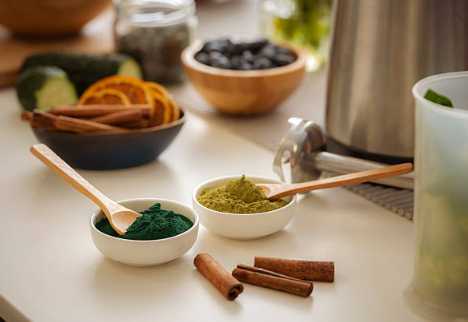Spirulina is a blue-green algae that has been consumed for centuries—dating back to the Aztecs and other Mesoamerican cultures in the 14th century—as a protein-rich food source. Once found only in specialty stores or online, it’s now widely available in most supermarkets. But what makes this aquatic superfood so appealing isn’t just its impressive nutrition and flavor—it’s also incredibly easy to use and environmentally sustainable.
Here’s everything you need to know about spirulina and why it deserves a spot in your smoothie.

Spirulina Nutrition at a Glance
Spirulina comes in vivid green and blue hues and is packed with vitamins, minerals, macronutrients, and plant compounds. This nutritional profile is what earns spirulina its superfood status.
Protein
Surprisingly rich in protein, spirulina delivers 16 grams of protein per ¼ cup. That’s significant, considering protein supports healthy bones, muscles, skin, hair, nails, and nearly every tissue in your body. It boosts immunity, aids in metabolic processes, helps repair tissues, prevents muscle loss, and even supports brain and red blood cell health.
Omega-3 Fatty Acids
Spirulina is a rare plant-based source of omega-3s, including both omega-3 and omega-6 fatty acids. These are essential for reducing inflammation and supporting cardiovascular and brain health.
B Vitamins
Spirulina is a good source of several B vitamins—especially thiamin (B1), riboflavin (B2), and niacin (B3)—which are critical for energy production and maintaining a healthy metabolism.
Iron
Just one tablespoon provides over 10% of your daily iron needs, which is vital for growth, development, and the production of hemoglobin—the protein in red blood cells that carries oxygen throughout the body.
Copper
Often overlooked, copper is essential for immune function and nerve health, and it also helps your body absorb iron—spirulina has plenty of it.
Manganese
Spirulina also contains manganese, which supports tissue growth, hormone production, bone health, and blood formation, as well as various metabolic functions.
Antioxidant Pigments
What sets spirulina apart is its high levels of antioxidant pigments and phytonutrients—including chlorophyll, carotenoids, phycocyanin, lutein, and zeaxanthin. These powerful compounds help reduce inflammation and protect against chronic diseases.

Health Benefits of Spirulina
Given its dense nutritional value, spirulina offers some impressive health perks.
1. Immune Support
Spirulina may help reduce inflammation, making your immune system more efficient. Its antioxidants combat free radicals, which are linked to aging and chronic illness.
2. Heart Health
Research shows spirulina can help lower total cholesterol, LDL (bad) cholesterol, and triglyceride levels, while potentially increasing HDL (good) cholesterol. Some studies also suggest it may aid in preventing and managing high blood pressure.
3. Sustainability
If you care about the environmental impact of your food, spirulina is one of the most eco-friendly supplements available. It has a low carbon footprint, grows rapidly (harvestable in 2–3 weeks), and can be cultivated using hydroponic methods in oceans—requiring little to no freshwater. NASA has even studied spirulina as a potential space nutrition and biofuel source for astronauts.
How to Add Spirulina to Your Routine
Before you rush to the grocery store or your favorite smoothie bar, here are a few things to keep in mind:
-
Choose quality: Spirulina grown in unregulated environments can absorb environmental toxins. Look for brands that are third-party tested for purity.
-
Medical precautions: Spirulina may affect blood clotting, so speak with your healthcare provider if you have clotting disorders. It also contains phenylalanine, which is harmful for people with PKU (phenylketonuria). Those who are pregnant, breastfeeding, or immunocompromised should consult a doctor before using it.
Recommended Dosage
There’s no official dosage, but most experts agree that 1 to 3 grams daily is a good place to start, with up to 10 grams per day considered safe.
Easy Ways to Use Spirulina
Besides blending into smoothies, try these fun and simple options:
-
Stir a spoonful into fruit or veggie juice
-
Sprinkle on popcorn as a savory topping
-
Add to cocktails for a vibrant color boost
-
Bake into granola bars, muffins, or healthy cookies
-
Mix into salad dressings or dips like guacamole
-
Stir into sauces or pasta spreads
FAQs
Can I take spirulina in pill or capsule form?
Yes! Spirulina is widely available in both powder and tablet/capsule form. Nutritional value is similar—choose the one that best fits your lifestyle.
How should I store spirulina powder?
Check the label—some brands require refrigeration. Otherwise, store in an airtight container in a cool, dry, dark place, like a pantry. Avoid heat and humidity (like near the stove or fridge) to preserve its potency.
Is spirulina vegan?
Absolutely. Spirulina is vegan, gluten-free, and keto-friendly. Just check for any non-vegan additives in your chosen brand.
Spirulina is more than a passing trend—it’s a powerhouse of nutrients with benefits for your immune system, heart, and the planet. So next time you’re blending a smoothie, add a scoop of this marine superfood for a bold boost to your health.